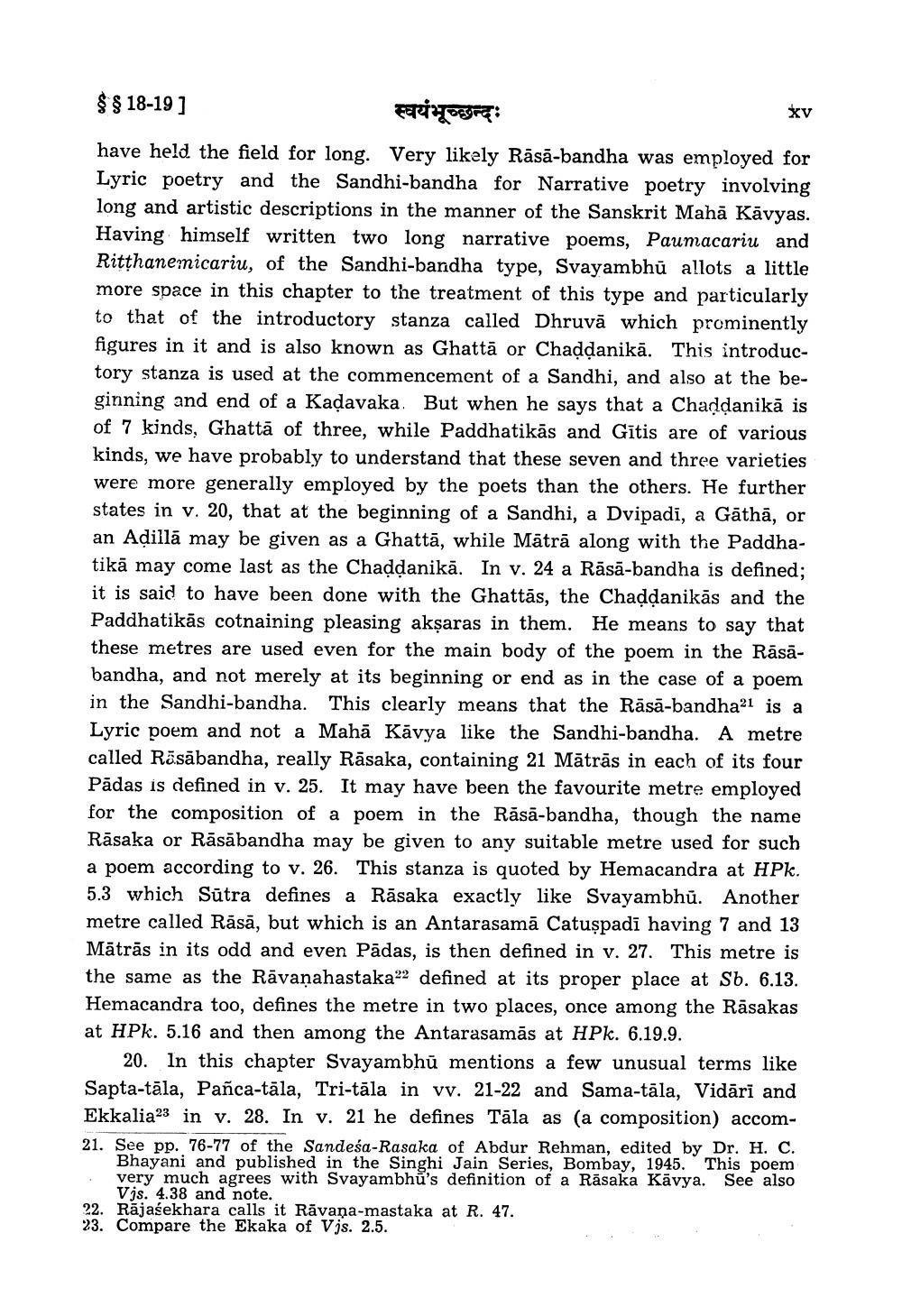________________
$ $ 18-19 ]
स्वयंभूच्छन्दः
XV
have held the field for long. Very likely Rāsā-bandha was employed for Lyric poetry and the Sandhi-bandha for Narrative poetry involving long and artistic descriptions in the manner of the Sanskrit Mahā Kāvyas. Having himself written two long narrative poems, Paumacariu and Ritthane?nicariu, of the Sandhi-bandha type, Svayambhū allots a little more space in this chapter to the treatment of this type and particularly to that of the introductory stanza called Dhruvā which prominently figures in it and is also known as Ghattā or Chaddanikā. This introductory stanza is used at the commencement of a Sandhi, and also at the beginning and end of a Kadavaka. But when he says that a Chaddanikā is of 7 kinds, Ghattā of three, while Paddhatikās and Gītis are of various kinds, we have probably to understand that these seven and three varieties were more generally employed by the poets than the others. He further states in v. 20, that at the beginning of a Sandhi, a Dvipadi, a Gāthā, or an Adillā may be given as a Ghattā, while Mātrā along with the Paddhatikā may come last as the Chaddanikā. In v. 24 a Rāsā-bandha is defined; it is said to have been done with the Ghattās, the Chaddanikās and the Paddhatikās cotnaining pleasing aksaras in them. He means to say that these metres are used even for the main body of the poem in the Rāsābandha, and not merely at its beginning or end as in the case of a poem in the Sandhi-bandha. This clearly means that the Rāsā-bandhaal is a Lyric poem and not a Mahā Kāvya like the Sandhi-bandha. A metre called Rāsābandha, really Rāsaka, containing 21 Mātrās in each of its four Pādas is defined in v. 25. It may have been the favourite metre employed for the composition of a poem in the Rāsā-bandha, though the name Rāsaka or Rāsābandha may be given to any suitable metre used for such a poem according to v. 26. This stanza is quoted by Hemacandra at HPk. 5.3 which Sūtra defines a Rāsaka exactly like Svayambhū. Another metre called Rāsā, but which is an Antarasamā Catușpadi having 7 and 13 Mātrās in its odd and even Pādas, is then defined in v. 27. This metre is the same as the Rāvanahastakao defined at its proper place at Sb. 6.13. Hemacandra too, defines the metre in two places, once among the Rāsakas at HPk. 5.16 and then among the Antarasamās at HPk. 6.19.9.
20. In this chapter Svayambhū mentions a few unusual terms like Sapta-tāla, Pañca-tāla, Tri-tāla in vy. 21-22 and Sama-tāla, Vidāri and Ekkalia23 in v. 28. In v. 21 he defines Tāla as (a composition) accom21. See pp. 76-77 of the Sandeśa-Rasaka of Abdur Rehman, edited by Dr. H. C.
Bhayani and published in the Singhi Jain Series, Bombay, 1945. This poem very much agrees with Svayambhu's definition of a Rāsaka Kāvya. See also
Vjs. 4.38 and note. 22. Rājasekhara calls it Răvaņa-mastaka at R. 47. 23. Compare the Ekaka of Vis. 2.5.




